The Guide of Marseille Calanques
Calanques South of Marseille
Stretching on a limestone massif of more than 5000 Hectars, stretching 20 km between Marseille and Cassis, the natural massif of Calanques is located at the gates of an urbanized area of more than one million inhabitants .
Its limestone rocks of dazzling whiteness, dotted with fragrant garrigue, plunge vertiginously into the turquoise waters of the Mediterranean Sea.
The calanques reveal a mineral universe where cape and valleys deep often inaccessible, calanques that appear as a surprise during the walk inviting you to an improvised and sometimes acrobatic bathing.
You will not be insensitive to their beauty, some are difficult to access like the calanque of Sugiton, and others offer facilities for the comfort of users.
- Click here to book a hotel near the calanques of Marseille
One of the strong points along the southern coast of France, these are the calanques of Marseille. It is a series of limestone cliffs, fjords and rocky promontories plunging into the Mediterranean on about 20 kilometers of coastline between Marseille and Cassis in Provence. In some of these places, pines cling to the sparkling rock, which accentuates the side both attractive and dramatic of their beauty.
Here you will find information on the beautiful calanques of Provence and our guides on the calanques of the Blue Coast, the calanques of Cassis and the calanques of La Ciotat.
Unfortunately, the calanques located between Marseille and Cassis were partially destroyed by a terrible forest fire in September 2016. As often, moreover, it is a criminal fire, which ravaged 3500 hectares of pine forest, which is not without consequences and some important impacts on the fragile ecosystem of this part of southern France. Some experts say it will take years for nature to rebuild itself and recover its pre-disaster charms.
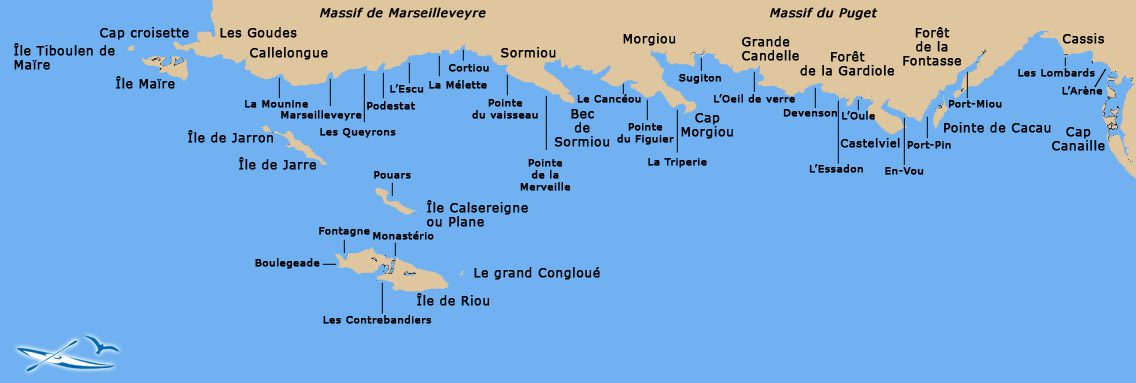
Map of the calanques of Marseille
If you are in the region of Marseille, and you run out of time, choose to visit the calanques by Bus Boats, this is the easiest way to see the calanques if you run out of time. You can then enjoy a guided tour.
You also have the opportunity to visit the calanques of Marseille with your own means of transport. They are accessible by car, served by car parks, and / or public transport (metro and bus). Then you will only have to walk on a protected path.
For safety reasons, and avoid fires road access to the coast and calanques will be restricted and even closed during the summer. If you want to leave your car in one of the car parks left for this purpose at the entrance of the calanques, know that they are quickly saturated and that vehicles are sometimes the target of flights of all kinds. A tip: do not leave anything visible in your cars.
Be prepared: if you go on foot to visit one of these calanques in Marseille, take some water, you will drink it, it is hot and the sun hits hard on the rocks, and equip yourself with walking shoes and possibly of a map. The paths can be sometimes steep. Even though the paths are marked, and many walkers, you never know. There is an IGN map of the hiking trails of the calanques of Marseille.
For those who want more, it would be wise then to invest in a guide on Les Calanques de Marseille. You can find many guides, such as Michelin or other guide Routard. In case ask at the reception of the Hotel, we will be happy to inform you about the discovery of the calanques of Marseille. All are different, and there is something for all tastes and levels of difficulty.
As we discussed earlier, the fire risks are so high in the summer that the law limits access between June 1 and September 30. There are three levels of risk: orange (access allowed), red (access allowed between 6am and 11am) and black (access forbidden).
The alert level varies depending on weather conditions and is set daily in the late afternoon for the next day.
You can consult it by phoning the telephone number of the official assistance, tel +33 8 11 20 13 13, in English and French and published on the Météo France website.
Remember that even on days when access is allowed, the heat of the sun amplified by the reverberation of limestone rock and reflected by the sea, will make your ride pleasant in the off-season, but stifling during the summer months. Remember to protect yourself with a hat, cap, sunscreen and carry plenty of water. The calanques of Marseille are beautiful, but sometimes they are deserved.
This beauty has also been recognized since the calanques of Marseille were officially declared national park in 2012. For this purpose also, some sports activities, hunting or fishing are even limited or prohibited.
You can consult the regulations governing visits to the Parc national des Calanques de Marseille.
Calanque de Marseille : Samena
It is the first calanque as such south of Marseille to be designated as calanque of Marseille on the map. It is located just below a restaurant with a magnificent view.
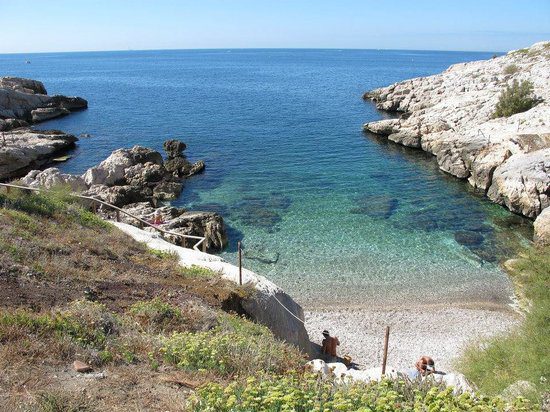
Marseille Calanque : Samena
When heading towards the Goudes it is the first of five small calanques facing west. The other calanques are those of Mauvais Pas, L’Escalette, Blanche and Les Trous. They all have their charm and their specificity, but they have the advantage of being close to the city and therefore are naturally crowded in summer and on weekends.
The main asset of the calanque of Samena is its proximity to the city of Marseille. There are other “calanques” in town, such as the Auffes Valley and the adjacent valleys, which are located squarely in the city, which have charm, (the proof of which has been filmed here), but in fact we do not we could classify them in the category of calanques, because they are different from others because they are located in an urban environment.
For a long time Samena suffered from pollution. The calanques were subjected at the beginning of the XX ° century to pollutant discharges of the chemical factories installed in the region. There are significant levels of arsenic, lead and sulfur. The calanque of Samena is supposed to be banned from this time, but it has been a long time since the signs prohibiting its access have disappeared.
Some divers from Marseille continue to frequent it in bad weather, because its orientation protects it naturally from bad weather. Of course, knowing that you can think twice before entering the water, telling you that the neoprene of your diving suit protects you. Successive municipalities have promised to clean up the place. In addition, the calanque is beautiful and the pebble beach is accessible by a staircase. After having lunch in the restaurant you can take one of the hiking trails for a digestive ballad, departing from the calanque of Samena.
About the restaurant, Les Tamaris, it has a large terrace overlooking the bay and you can enjoy a menu with specialties of the sea, specialties of Marseille (Pieds et paquets, squid stuffed, etc.) and pizzas over a wood fire. There are also several bed and breakfasts in Samena : La petite Calanque and Villa d’Orient.
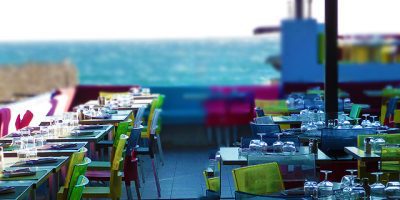
Restaurant le petit Port Marseille
The small port restaurant, L’Escalette, Marseille.
A little further along the road that leads to the Goudes, the Calanque de L’Escalette has a pizzeria, the little Port (photo blog Cecile Na), with candy-colored seats overlooking a deep and narrow picturesque entrance . The restaurant is quite famous, it serves good seafood, local dishes and also pizzas. The restaurant is open all year, but only on weekends in winter, you must book.
To go to the calanque of Saména:
Take metro lines 1 or 2, Castellane stop. Take bus 19 to Montredon (the end of the road). Then take the bus 20. Or you can walk from Montredon to the nearest calanques.
In summer, you can take the shuttle boat service – the “batobus” that takes you from the center of Marseille : between the Old Port and Pointe Rouge.
The calanque of Callelongue
We always stay on this famous Goudes road to visit the calanque Callelongue which is just a little further. The village of Goudes gives you a last glimpse of the horizon of Marseille. After that, the road follows a side cut by the sea and the landscape really begins to become wild.
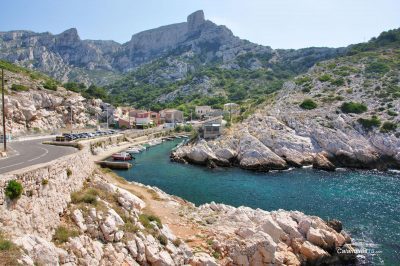
Calanque of CalleLongue. Marseilles
It is a small village attached to its port, and is made up of a small group of houses. You can still see the remains of the former soda factory (for Marseille soaps). The port is all in length, with a petanque and at its end a tiny sandy beach. You will also find a UCPA camp for diving which is located at Cap Croisette between the calanque of Callelongue and the Port des Goudes.
Watch out for the rusty remains of the pulleys of this first submarine cable car, an underwater cable car that offered the opportunity to walk under the sea for ten minutes on the sand. The experiment lasted for a year in the late 1960s.
And if there must be a pearl in this Calanque de Marseille, it’s the restaurant “La Grotte” it is. This is a magical place to eat, the setting is superb and the food excellent. The Restaurant la Grotte in Callelongue is open all year and serves fresh fish and grilled meat, all very well prepared with excellent service. The patio will delight you during the warm summer evenings, and its room decorated early twentieth. The restaurant has a wood oven for its famous Pizzas.
To avoid spoiling ask the wine list, you can taste beautiful bottles of the best local wines. Recently la Grotte has also opened its brewery, which overlooks the port of the calanque.
From Callelongue, start the hiking trail Customs (GR98) which takes you around the calanques. By taking it for about 2 km along the coast you will reach the calanque next to Marseilleveyre and its pebble beach and its famous bar-restaurant, “Chez le Belge”.
Go to the calanque of Callelongue:
Ditto take the metro line 1 or 2, stop Castellane. Change to bus 19 to Montredon (the end of the road). Then take bus 20 until the end of this road.
Calanque of Sormiou
The calanque of Sormiou is one of the most famous calanques of Marseille. One of the reasons it is famous is that she is private, her famous cabanons all belong to Sormiou’s descendant of Marie. Tenants pass on this right from generation to generation. You arrive by car through the sad suburbs of Marseille not without having crossed the southern districts.
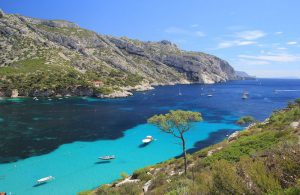
Marseille calanque : Sormiou
Then suddenly the mountain is there and its wild nature too. It’s actually a real surprise to suddenly enter the wilderness. And, full summer you will not be able either to take the road of the pass it will be necessary to leave your car at the carpark at the bottom unless you go to eat at the castle the famous restaurant which dominates the calanque of Sormiou. The route is impressive for those who are not accustomed to steep mountain roads and by borrowing it, you will cross a wild countryside where it is not uncommon to cross wild animals late at night when returning.
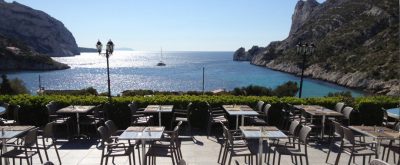
Restaurant Le Chateau, calanque of Sormiou in Marseille
From Marseille’s Calanque car park in Sormiou is a 15-minute drive and an hour’s walk from the car park and you cross exceptional landscapes.
Already down the pass, the road is impressive and you will discover a magical landscape with postcard colors. Before reaching the sea, you will cross groups of cabanas before arriving on a white sand beach. Here neither running water nor electricity.
You can walk along the waterfront on well-maintained paths or climb the hills in search of performance for trails, the area is known for that too. The calanque of Sormiou has a sports center reserved for cabanoniers for kayak tours, scuba diving. The place is also famous for its climbing spots.
The former owner of the site had a building, slightly set back from the waterfront, on a high part he had named “The Castle”. This house has since been transformed into a restaurant with an extraordinary view of the calanque of Marseille. It is always called the Castle “. A modest restaurant much appreciated by the locals for its excellent bouillabaisse and its extraordinary Zarzuela.
You must reserve a table by phone and its dishes in advance. – tel (+33) 4 91 25 08 69. The restaurant only takes cash.
The little extra : as said before the reservation at the castle restaurant allows you to enter the calanque by car, even in summer. The restaurant will ask you for your registration number and this will allow you to cross the barrier at the beginning of the calanque.
Go to the calanque of Sormiou :
By car head south from Marseille along the coast and turn inside the roundabout through Bonneveine beach in the ninth arrondissement. From then on, the calanque of Sormiou is very well reported. After the parking of Cayolle, the entrance to the calanque is a single-lane road that winds through the pine forest and scrubland.
Once past the Sormiou pass, a spectacular descent awaits you. All turns are hairpin blind, so be sure to be comfortable on narrow mountain roads, use engine braking and have good reflexes. The descent takes about 15 minutes, depending on traffic and paid parking awaits you downstairs, payment in cash only.
As elsewhere, the regulation of calanques applies, the calanque Sormiou is closed to cars on weekends and holidays in mid-season and every day in the middle of summer.
You can park your car at the parking of Cayolle, down at the entrance of the calanque (the area is not famous) from where you can go to the beach by walking in about an hour. There is another parking at the pass.
Otherwise to go to the calanque of Sormiou take the metro line 2, direction Sainte Marguerite Dromel, stop at Rond-Point du Prado. Then take bus 23 for Sormiou / La Cayolle. From there, you are about 45 minutes walk from the bottom of the calanque.
Calanque de Morgiou in Marseille
One of the most beautiful calanques of Marseille, Morgiou is also very difficult to access, although its route is less impressive than that of Sormiou because it is surrounded by dense vegetation that prevents the view down, which makes its approach less spectacular.
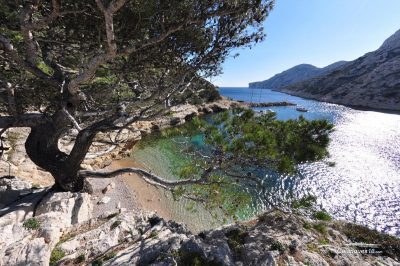
Marseille Calanque Morgiou
Unlike Sormiou, the houses of Morgiou go back to the bottom and the interior of the calanque and are not all aligned on the waterfront. It is less like being here on a weekend resort destination. but more like a place to live in everyday life. This calanque, very beautiful, is also a place of life with its consequent port which shelters many boats in the year.
If one is interested in the history, the official site of Morgiou will inform you on this village; among others in 1452, the Good King René sold the calanque to the local fishermen for 1200 florins and, in 1622, King Louis XIII went to fetch more than 25 tunas with a golden silver trident. Stairs even bear his name.
Morgiou has also become famous in the world, for its archaeological side with the discovery of the cave of Cosquer and its famous animal paintings and hand prints, dating from the Paleolithic era. This is proof that sea level has increased at the end of the last ice age, as the entrance to the cave is now 35 meters below the surface of the water.
The cave was discovered by the diver Henri Cosquer in 1985. It is the only cave with rock paintings in the world with an entrance submerged under the sea. For various reasons the discovery of the cave and its contents was made public only in 1991, when three divers got lost inside and died.
Today, the entrance to the cave is closed, to protect the paintings. On the other hand, these are always visible during a virtual tour of the Cosquer cave.
You can eat in the calanque of Morgiou bar Nautic. You can enjoy drinks and light meals, which you can enjoy on a small terrace or in a cozy corner under picturesque photographs of the calanque of the old days.
You can also rent rooms. The bar is open all year. Tel (+33) 4 91 40 06 37. Closed Sunday and Monday.
To go to the calanque of Morgiou :
You have to cross the district of the famous prison Baumettes to find parking at the entrance to the calanque. Or take metro line 2, direction Sainte Marguerite Dromel, Rond-Point du Prado stop. Then bus 22 to Les Baumettes (the end of the road).
Calanque of Sugiton in Marseille
This calanque of Marseille is deserved ! The calanque of Sugiton is probably the best known calanques south of Marseille by the beauty of its path and breathtaking views, as well as the difficulty of its path. Equip yourself with good shoes and bottles of water. The concrete path down to the calanque of Sugiton is steep and winding, but also well marked, with many information panels. The last part is difficult. Count 60 ‘of travel time.
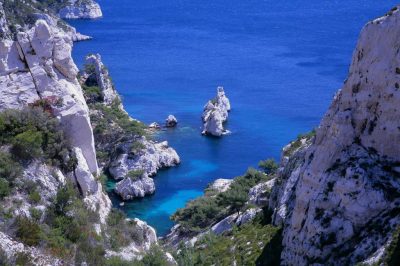
Calanque of Sugiton, Marseille
At the top of the pass after a few minutes of a carriage road and easy is a belvedere that offers a breathtaking view of the Calanque of Morgiou, At the highest peak, La Candelle, you can admire a spectacular rock finger of 460 meters of high that overlooks the calanque, with below an island known as Torpedo (photo).
The calanque of Sugiton is less prone to closing during the summer than all the other calanques of Marseille, which makes it very popular with natives.
Once arrived on site, no sand beach. You will find only two small calanques with pebble beaches very difficult to access overcrowded in summer, and where people are sometimes forced to perch high on the walls overlooking the calanque to be brown under the rays of sun. The coastal path will take you to the calanques near Morgiou in one direction and that of L’Oeil de Verre to the other. No bar here, there is no place, plan what to eat and hydrate you.
The little extra : the presence of a nudist beach nearby, Les Pierres Tombées, which is still used by nudists, while it was officially closed to the public in 2006, following a dead rock fall from the cliff overhanging it.
Go to the calanque of Sugiton:
By road go to the university campus of Luminy (there is a large car park), then it takes an hour to hike to the sea. Or take the metro line 2, direction Sainte Marguerite Dromel, stop Rond Point Prado. Then bus 21 to Luminy (the end of the road).
RELATED ARTICLES
Old Port of Marseille
Beaches of Marseille
Edmond Rostand Hotel
Old Town in Marseille
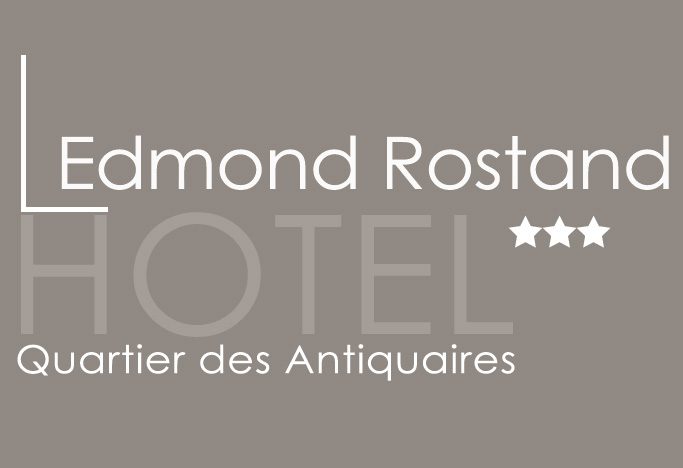
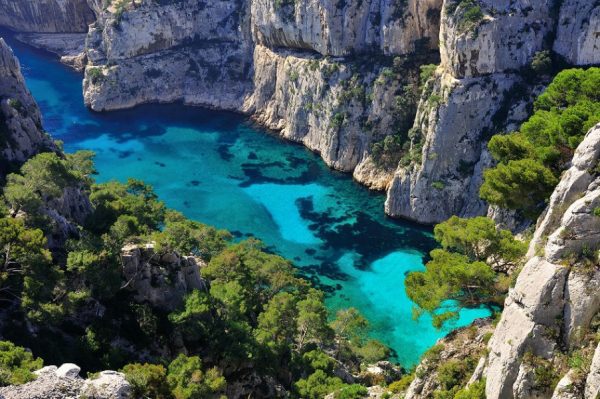
0 Comments